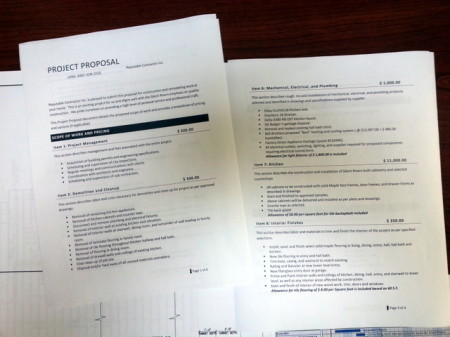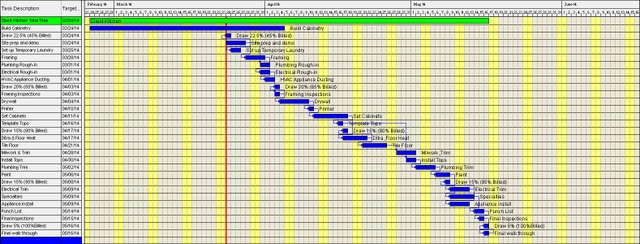We have all heard the phrase “You get what you pay for.” Unfortunately, it is often uttered in frustration with the disappointing results of a big investment. Sometimes decisions were made that impacted the quality in order to save money. Sometimes the tradeoffs weren’t fully understood.
When considering a remodeling or construction project, how do you make sure you will receive the quality and aesthetic results you want?
Construction and… Cars?
Construction and remodeling work is extremely complex. Think of all the parts and pieces that go into a kitchen: framing, drywall, plumbing, electrical, heating/cooling, paint, tile, cabinets, light fixtures, appliances, counters. Everything has to work together as a system, and each house is unique.
Cars are also extremely complex, but they are more-or-less standardized. When you buy a new car you have the ability to see it, touch it, and smell it – even take it for a spin – before signing over your hard earned cash. Remodeling, renovation, or even small home repair jobs do not often have the same opportunity. You must rely on the contractor to provide the desired results. There is a level of trust that must be established because you can’t “kick the tires” ahead of time.

The “Napkin Bid” isn’t a good agreement. If the project is not fully described in drawings, details, specifications, and text, how do you know what you are getting?
The contractor’s promise to do a good job can come in a variety of forms. Sometimes it comes in the form of a one page hand-written estimate on store-bought generic forms that state: “Kitchen Remodel to be Completed for $____.” You think you’re in good hands… After all, he did a good job for your sister’s co-worker’s brother’s friend. But in a brief “promise” to do work on such a complex project, there is a lot left open to interpretation.
You may not be able to test drive your kitchen remodel or room addition before committing to pay for it, but you certainly deserve to know what is going into it. When preparing for a project of any size, there are two key parts to a thorough agreement:
1. Clearly define work to be done through drawings, specifications, and written descriptions.
2. Obtain a written schedule from beginning to end.
An agreement that includes these parts will go a long way towards minimizing the chance for misunderstandings through the course of the project.
Defining the Work Required
A professional construction firm should provide you with a thorough Scope of Work – a written description of the work to be performed that includes specific information about what is going into your project, such as material selections and product specifications. It is important to identify in writing what exactly is included in the project so as to reduce the potential for extra charges; doing so helps to improve communication and protects both the home-owner and the contractor.

A complete project proposal should define the full scope of the project (broken down into “bite-sized” chunks), specific products, and defined pricing.
You do not want to get caught in the “I thought we talked about that” scenario, as oral agreements are open to different interpretations. Upfront planning and clearly written documentation helps ensure a smooth construction process, limiting most unknowns before the project begins.
Plan to Schedule – Scheduling the Plan
Project schedule is another area where a clear agreement can alleviate potential disagreements later on. “How long will the project take,” you ask? Remodeling work is notorious for taking longer than planned or promised. There are a lot of variables that go into remodeling projects that make scheduling difficult. For example, a kitchen sink delivered in damaged condition impacts more than just its own installation date. It also directly affects the plumbing, countertop, and backsplash. Exterior project schedules are often defined by weather.
More often than not, however, missed deadlines result from the lack of a written schedule, a wild guess on behalf of the contractor, or poor communication with trade associates and suppliers. A written schedule is crucial to successful project completion and enhances you awareness of the project. Agreement between the contractor and the homeowner on a specific timeline broken down into individual tasks improves performance and helps keep everyone on the same page – even when legitimate or unfortunate delays occur.

A Gantt chart organizes construction tasks into a “critical path” display to show the length and order for project completion.
A complete schedule should include key landmarks like material and product order and delivery dates, planned sub-contractors start and finish dates, key inspections as well as product installations. A good schedule should be both dependable yet flexible enough to absorb reasonable accommodation to jobsite conditions. It becomes a working tool to assist with project efficiency, and communication tool between the owner and the contractor.
You CAN Get What You Pay For
It’s all about investing the time and effort up front to establish clear and complete expectations:
- What exactly am I getting
- How long will it take and what are the milestones
- How much will it cost
An efficient schedule and clearly written scope help avoid surprises and disappointment during construction. Both the contractor and the client will enjoy the process more and experience the satisfaction of a well-run project. You, the client will be able to say, “Yes, I got what I paid for!”
And be happy that you did.